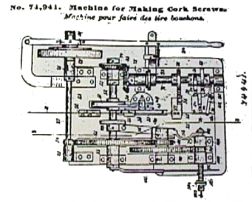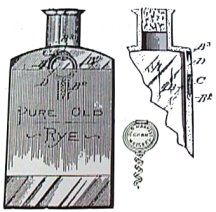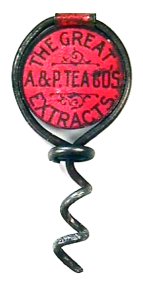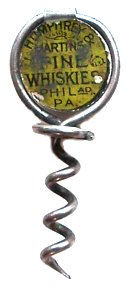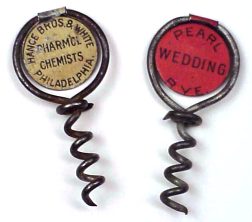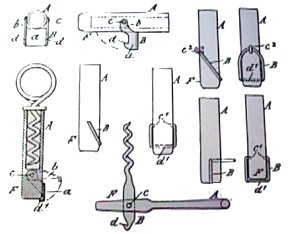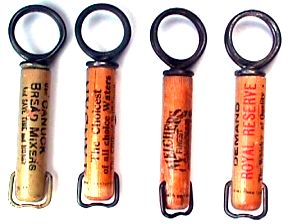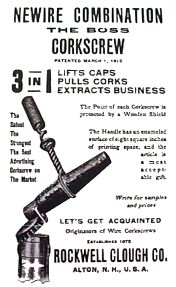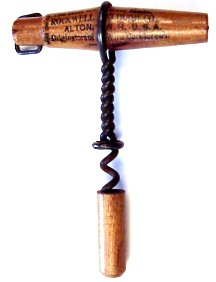|
William Rockwell Clough
Inventor and
Manufacturer of over a Billion Corkscrews
©2002 Ron
MacLean |
Clough Related Corkscrew
Patents
1901-1920
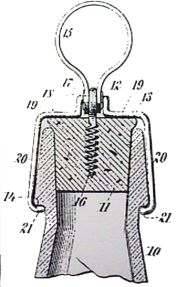 |
1904 December 27 U.S. Patent No.
778,593 - Applied for April 6, 1904 - "Closure for Bottles or the Like" granted
to Alexander Maconnell possibly the son of James Maconnell, (Clough's frequent
partner) for a Closure for Bottles incorporating a Clough type metal band wire
corkscrew. The patent attorney was non other than Charles C. Gill, Clough's
patent attorney. It may be presumed that Clough had more than a passive
awareness of this related invention. |
____________________
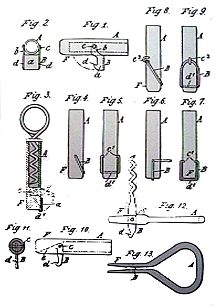 |
1908 May 7 British Patent No. 20,272
Decapitator was granted to Clough while living in London, England for a number
of crown cap lifter devices called "Decapitators" which were normally fitted to
the wooden sheaths of his wire corkscrews. English examples (below) with a
stamped steel decapitator have been found marked "PATENT NO 20272,
1907". 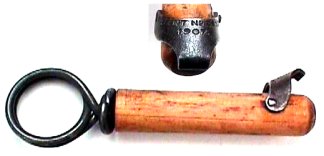 |
____________________

1910 March 1 U.S. Patent No. 950,509 Applied
for October 17, 1907 "Bottle Cap Lifter" (Decapitator) Granted to Clough for
decapitators similar to the English Patent 20,272 . Examples of this patent may
often be found on sheaths with one variant called the "Newire Combination The
Boss" on a handbill (below left) and shows the caplifter wire attachment fitted
to one end of a wooden handle. An advertising model which W.R. Clough called
"THE BOSS NEWIRE" with the handle (below right) almost completely covered with
Clough advertising is marked It's Wise To Advertise! Get Wise And Use This
NEWWIRE COMBINATION Corkscrew and Cap-Lifter / The Best We Ever Made / ROCKWELL
CLOUGH CO. ALTON, N.H. U.S.A. / WRC Originators of Wire Corkscrews. WIRE
CAP-LIFTER PAT. MAR 1, 1910

|
Jack Bandy's patent files which showed
that the 1886 William Crabb patent attorney was no other than W.R. Clough, also
answered another question, the meaning of the expression "Patent Allowed". One
Clough "Decapitator" corkscrew (March 1, 1910 U.S. Patent) has the words
"Clough Patent Allowed" on the caplifter arm. No one seemed to know what this
meant but one of the forms in a complete file states "Your patent has been
examined and ALLOWED". It then goes on to state that the patent applicant has
six months to pay the final fee of Twenty Dollars in order to obtain his
patent. By waiting the full six months an inventor could extend the life of his
patent by the same period with very little, if any, risk of patent
infringement. |

1914 December 15 U.S. Patent No. 1,120,906 -
Applied for April 16, 1911 Bottle Attachment Clough was granted U.S. Patent No.
1,120,906 of December 15, 1914 for a Bottle Attachment for securing a wire
corkscrew. This was simply a piece of bent wire/flat steel to secure a
corkscrew to a bottle neck during transport. It is not known if any examples
have been found.

1920 May 4 U.S. Patent No. 1,339,164 - Applied
for June 28, 1918 - "Pocket Implement" (Wire Helixes for Pocket Knives Granted
to Clough for a Pocket Implement (Knife with wire corkscrew). This patent was
basically for a wire section for the corkscrew portion of a knife to
"materially simplify and lessen the cost of the manufacture of corkscrews" for
pocket knives. This patent was presumably pursued to help establish a new
market for his wire helix manufacturing interests.
Book Cover
Page
©2002, 2003
Ron MacLean
Book Designer and Webmaster:
Donald A. Bull
The Virtual Corkscrew
Museum
